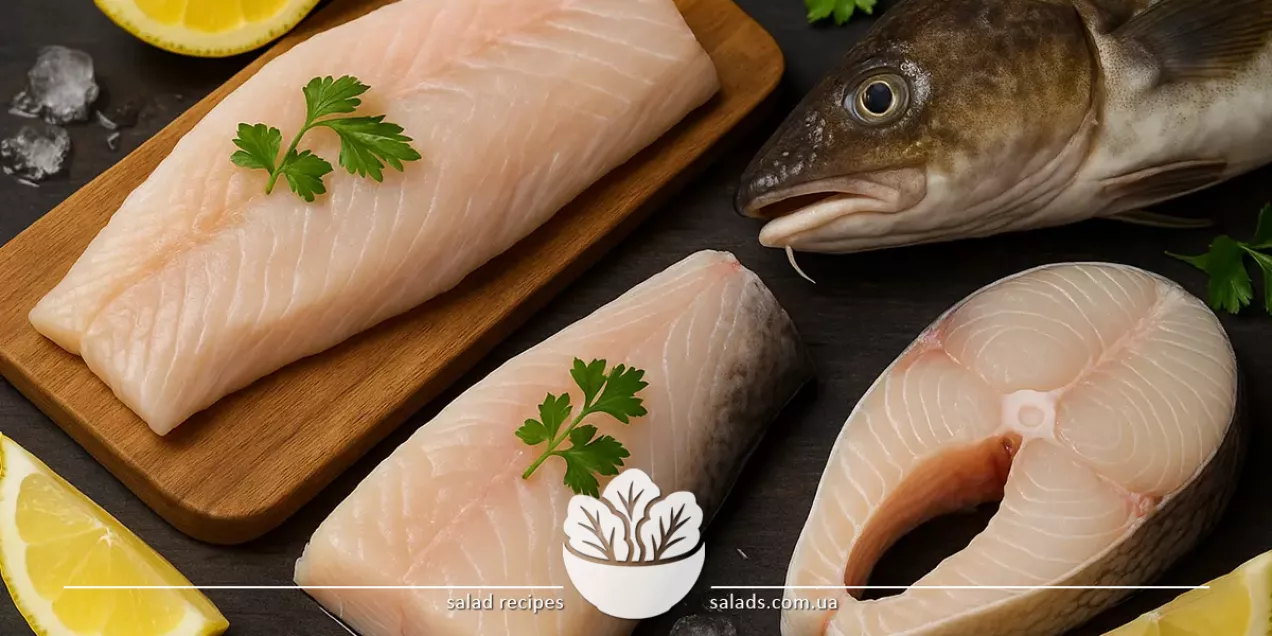Cod

Cod is a white sea fish known for its tender flesh, minimal fat, and broad culinary versatility. It is easily digestible, free of small bones, and remains popular worldwide due to its adaptability. Cod is widely used in both everyday cooking and restaurant dishes, most often prepared by baking or steaming. Within the fish category, cod occupies a special niche as a product of high dietary value.
Types of Cod
Fresh Cod – A Versatile Base for Healthy Meals
Fresh cod is one of the purest and most neutral-tasting fish ingredients, making it ideal for everyday diets. Its flesh is snow-white, tender, yet firm enough to hold its shape during boiling, frying, stewing, or baking. Thanks to its low fat content, cod is considered a perfect option for those following calorie-controlled diets or simply preferring light and balanced meals. Fresh cod is widely used in cooking. It is prepared as fillets, steaks, or small portion-sized pieces that are easy to handle and require no complex preparation. Cod is most commonly baked in the oven with vegetables, cooked in creamy or tomato sauces, or steamed with herbs. For example, cod steamed with broccoli and chicken eggs can be a complete and balanced breakfast or lunch.
Fresh cod pairs well with neutral side dishes – potatoes, rice, vegetable purée – and light sauces made with yogurt or lemon juice. It is a suitable choice for children's meals, as its flesh has no strong odor and is easily digested. It is also ideal for people with sensitive digestion or during recovery. Despite its simplicity, cod remains a staple ingredient in many global cuisines. It easily adapts to various culinary styles – from Scandinavian to Mediterranean – and does not require many spices, as its natural flavor is refined and balanced.
Cod Fillet – Convenient, Safe, and Versatile
Cod fillet is the most convenient form for daily use of this fish. It is completely cleaned of skin and bones, has a delicate texture and a neutral aroma, making it ideal for quick meals as well as for diet-friendly dishes. Thanks to its uniform structure, the fillet holds together during cooking and is excellent for baking, boiling, steaming, stewing, and even pan-frying. This product is especially convenient for family meals: it is safe for children and people with higher quality standards for food. The fillet is easily digestible, does not cause heaviness, and provides a sufficient amount of complete protein. For example, cod fillet baked with spices and apples becomes a delicate yet flavorful dish suitable even for festive occasions.
Fillet is often used as a base for fish patties, casseroles, spreads, or pâtés. It can be easily chopped in a blender or meat grinder, retaining its softness and pleasant texture. Thanks to its low fat content, the fillet pairs well with creamy sauces, cheeses, herbs, or vegetables without overwhelming the flavor or caloric content of the dish. Another advantage is its portionability: the fillet can be stored frozen in pieces of desired size. This is convenient for meal planning – simply take out the required amount and quickly prepare a complete dish without complex steps. Cod fillet is the foundation for countless recipes where health meets flavor.
Baked Cod – Easy to Cook, Culinary Flexibility
Baked cod is one of the most popular ways to prepare this fish, combining convenience, speed, and nutrition. Thanks to its tender texture and low fat, cod fillet does not dry out in the oven and retains its tenderness and pleasant flavor. Baked cod dishes are suitable for everyday meals, diet menus, and festive tables thanks to their appealing look and light taste. Cod is most often baked with vegetables, herbs, and light sauces – creamy, lemon-based, tomato, or Greek yogurt sauces. To prevent drying out, cod is often cooked covered or in foil, sometimes with added liquids like broth, white wine, or citrus juice. For example, cod baked with grilled vegetables and grated cheese is a nourishing yet light meal for the whole family.
Cod’s culinary flexibility allows for variations in spices, sides, and presentation depending on the season and cuisine. In Mediterranean style, it’s cooked with tomatoes, basil, and olives; in Scandinavian cuisine – with root vegetables and dill; and in modern versions – as baked portions with grains or even fruit. This makes it easy to adapt cod to different preferences. Besides its great taste, baked cod retains essential nutrients: complete protein, iodine, phosphorus, vitamins D and B12. This preparation method does not require large amounts of fat, making it an ideal choice for light but satisfying meals any day of the week.
Cod in Soups and Broths – Light, Aromatic, and Nutritious
Cod is an ideal ingredient for fish soups, as its flesh holds shape in broth, doesn’t fall apart, and doesn’t overpower other flavors. Cod broth is clear, delicate, and aromatic, while the fish itself pairs harmoniously with vegetables, herbs, spices, and grains. Thanks to its low fat and mild taste, cod is suitable for light soups and richer fish stews with vegetable bases. A unique feature of cod is its quick cooking time – just a few minutes in hot broth is enough to make the fillet tender and ready to eat. This helps preserve all nutrients, especially protein, vitamins B12 and D, and essential minerals. For example, a light soup with cod, carrots, green peas, and rice is an ideal lunch for children, the elderly, or those recovering from illness.
Cod can be used in traditional fish soups, creamy soups, purées with potatoes or cauliflower. It combines well with fragrant herbs such as thyme, dill, parsley, and with subtle creamy or citrusy notes. In soups, cod is often combined with carrots, onions, celery, garlic, and even fermented dairy products if the recipe includes light sauces or creamy broths. Another advantage is that cod doesn’t produce a strong odor during cooking – unlike some other types of fish. This allows you to prepare it even in open kitchens or serve it at family lunches without worrying about lingering smells. Cod-based soups are a simple, healthy, and accessible way to diversify the menu and provide quality protein.
Cod’s Nutritional Value – Maximum Benefit with Minimal Calories
Cod is a prime example of a high-protein, low-fat food, making it an ideal choice for healthy, balanced nutrition. 100 grams of cod fillet contain about 16 g of protein and only 0.6 g of fat, with a caloric value of no more than 80-90 kcal. As a result, cod is often included in weight-loss diets, sports menus, and medical and child nutrition plans. This fish is a source of complete, highly digestible protein and contains vital micronutrients – iodine, phosphorus, selenium, potassium, and magnesium. Especially noteworthy is its high vitamin B12 content, essential for nervous system function and blood formation, as well as vitamin D, important for bone health and immune function. Thanks to its low fat content, cod can be easily combined with other nutritious ingredients without burdening the body.
This product suits those limiting fat intake or avoiding high-calorie animal products. When paired with vegetables, grains, light sauces, and fruity notes, cod creates balanced everyday meals. For example, cod with herring in a fish platter topped with herbs provides complete protein and micronutrients without excess fat. Thanks to its composition, cod is recommended by nutritionists and gastroenterologists for consumption at least twice a week. It not only supports healthy metabolism but also offers a pleasant flavor, making it suitable for a variety of recipes without compromising on culinary enjoyment.
